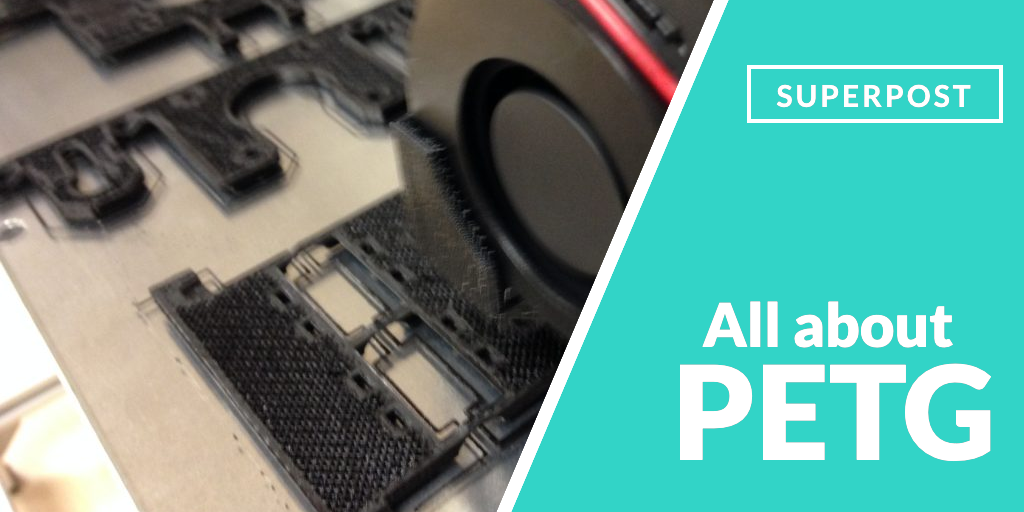PETG is one of the most versatile 3D printing materials, strong and easy to print. It is getting more popular each day and many 3D printer owners and 3D printing services are starting to use it for their printed parts.
Here you will find all the information you need to know to start using PETG, gathered thanks to our experience printing in PETG for our customers. We have updated this post in 2019 so you can find the most up to date information!
Let’s print PETG! 💪
📖 What do you want to read?
What are PET and PETG?
PET (polyethylene terephthalate) is the most used plastic in the world: you can find it in bottles, food containers, textile fibers … It is a transparent material, with very good chemical resistance and suitable for food use. The PET variant that we use in 3D printing is PETG. The G at the end means Glycol-modified, and refers to a change in the chemical structure of the polymer that makes it more transparent, less fragile and easier to process than the common PET. With these improvements and its ease of printing the PETG has become one of the most used materials in 3D printing.
What are the properties of PETG (PETG vs PLA and PETG vs ABS)
PETG is a 3D printing material with very good mechanical properties. To explore its possibilities, we will compare its properties with the other two most popular plastics, ABS and PLA. We compare PETG vs PLA and PETG vs ABS so you can choose the right material for your 3D printing project. The general rules that you can follow to understand the PETG are:- Rigidity. We call rigidity the difficulty of a material to be deformed (for example, bent or stretched). The PETG is a less rigid material (more elastic) than the PLA: it is easier to bend it and it is less fragile than the PLA. It is also less rigid than ABS, but in this case the difference is much smaller.
- Resistance. In general, the PETG resists the blows, the efforts and “it is more difficult to break” than the PLA and ABS, therefore it is stronger or has greater resistance. In addition to having better properties on paper than ABS (often considered a strong plastic in 3D printing), the higher adhesion of the layers makes PETG pieces even more resistant in practice.
- Resistance to temperature. PETG is a little more resistant to temperature than PLA, but less than ABS. The PETG begins to soften at 80ºC, more than the PLA (70ºC) but less temperature than the ABS (105Cº)
Other interesting properties of PETG
In addition to good mechanical properties and greater resistance to temperature than PLA, there are other properties that make PETG very interesting for specific uses:- Approval for food use. The PETG has the approval of the FDA (the US agency that regulates food, medicines and cosmetics) for food use. It is a characteristic with which one must be cautious in the case of pieces printed with PETG, which are printed or stored in an uncontrolled environment, which may come into contact with contaminants and which have cavities and grooves that are difficult to sterilize.
- Chemical resistance. The PETG is very stable and chemically resistant to the attack of acids and bases.
- Transparency. PETG in its natural state (without colorants) allows around 90% of the light to pass through, making it suitable for printing transparent or translucent parts.
- Odorless printing. Unlike ABS and similar to PLA (which smells when printed but is not a strong or unpleasant odor) PETG does not produce odor when printed.
- Recyclable. Being the material used in bottles and food containers, we already have an infrastructure to recycle the PETG! This infrastructure in Spain is the one that starts in the yellow container. You can throw away your failed prints and used pieces along with the containers and bottles to be recycled.
How to print PETG
The PETG is an easy material to print. You only need to change some parameters to go from PLA (the easiest material to use) to print your first pieces in PETG. We want to share the parameters and tricks that we use in Bitfab to print the PETG:- Extrusion temperature. The PETG is usually printed at 220-250º, somewhat hotter than the PLA. Because it can be printed below 235 °, it is possible to print it with any existing hotend (including those with PTFE inner tube), it is not necessary to use a 100% metallic hotend.
- Printing surface. It is highly recommended to use a hot bed to print PETG. The ideal temperature of the surface is between 60 and 90 degrees, somewhat higher than the PLA but without reaching the ABS. In Bitfab we use glass surfaces and hairspray-type fixation to obtain a good adhesion of the first layer.
- Open printers. PETG can be printed on open printers, Prusa type, without the need for a enclosed printer.
- Layer fan. To improve the quality of the parts, it is recommended to use a layer fan when printing PETG.
- Warping. PETG has a reduced thermal contraction, so it is not prone to warping and results in parts with good dimensional tolerances. Warping will only appear in large parts, more or less the same as PLA.

In summary
The PETG is one of the most interesting materials for 3D printing. It combines the best features of the two most popular plastics: mechanical properties superior to those of ABS and the ease of printing and finishing the PLA. Choose it for your toughest pieces or when you need to withstand the attack of chemical products.Make your parts in PETG with Bitfab
This week we have started to offer PETG as a printing material in our service, you can already enjoy the excellent mechanical properties and the PETG finish for your most demanding parts.

